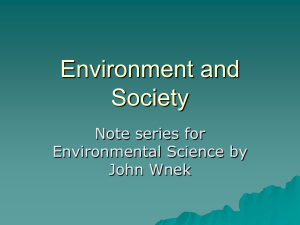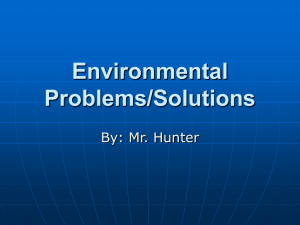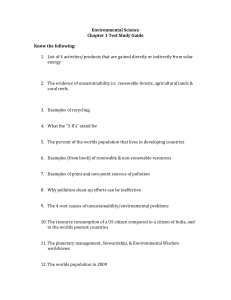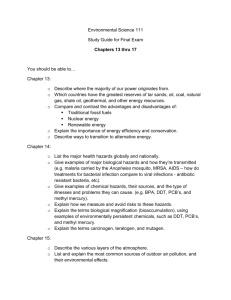STATE UNIVERSITY OF NEW YORK COLLEGE OF TECHNOLOGY CANTON, NEW YORK
advertisement
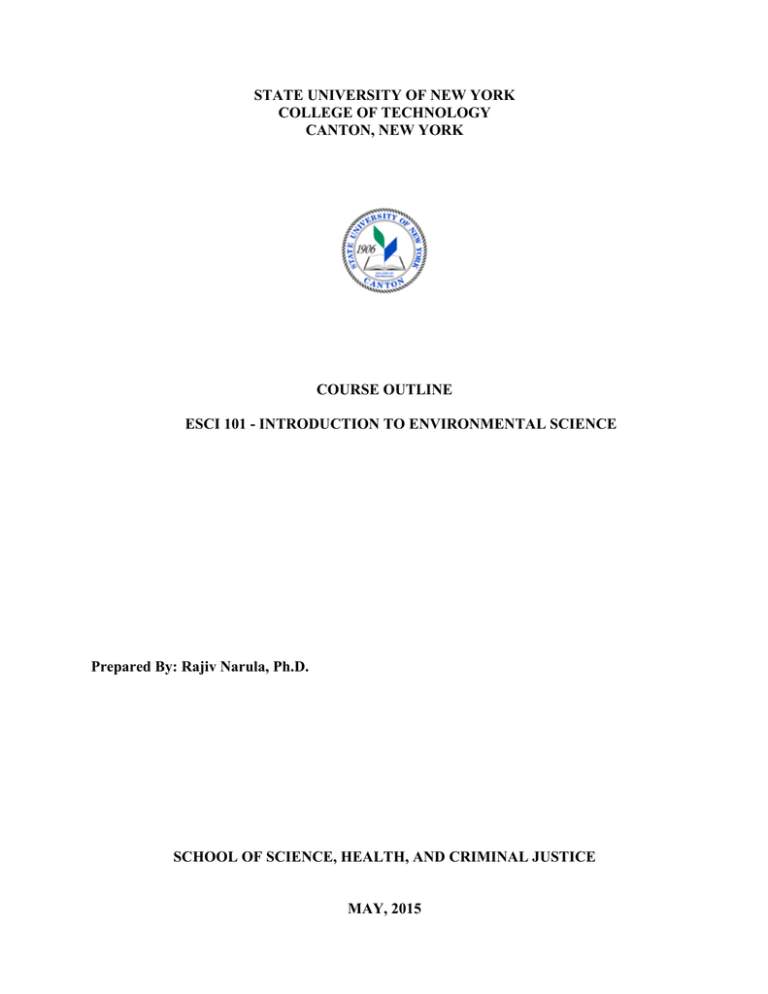
STATE UNIVERSITY OF NEW YORK COLLEGE OF TECHNOLOGY CANTON, NEW YORK COURSE OUTLINE ESCI 101 - INTRODUCTION TO ENVIRONMENTAL SCIENCE Prepared By: Rajiv Narula, Ph.D. SCHOOL OF SCIENCE, HEALTH, AND CRIMINAL JUSTICE MAY, 2015 A. TITLE: Introduction to Environmental Science B. COURSE NUMBER: ESCI 101 C. CREDIT HOURS: (3) D. WRITING INTENSIVE COURSE: No E. COURSE LENGTH: 15 weeks F. SEMESTER(S) OFFERED: Both Fall and Spring G. HOURS OF LECTURE, LABORATORY, RECITATION, TUTORIAL, ACTIVITY: 2.5 lecture hours per week H. CATALOG DESCRIPTION: This is an overview of environmental science that will include sustainability, natural resources, population growth and demographics, urbanization, food resources, renewable and non-renewable energy, species extinction, land degradation, water and air pollution, climate change, wastes, and environmental health hazards. It is designed for those students who have had little or no background of environmental science. I. PRE-REQUISITES/CO-REQUISITES: (List courses or indicate “none”) a. Pre-requisite(s): ENGL 101(Expository Writing) OR ENGL 102 (Oral and Written Expression) OR an 80 grade on the Regents English Language Arts Examination b. Co-requisite(s): None 2 J. GOALS (STUDENT LEARNING OUTCOMES): By the end of this course, the student will be able to: Course Student Learning Outcomes Institutional Student Learning Outcomes 1. Understand the Scientific Method and apply it Professional Competence to develop problem solving skills, Describe the Critical Thinking current condition of planet Earth with respect to sustainability, Differentiate between environmental impacts of developed and developing countries 2. Define the basic principles of human Professional Competence population ecology and the effects on the Communication environment using the IPAT model, Understand and be able to explain the effects of urbanization, Describe food resources and environmental impacts of food production and transport 3. Describe the fundamental energy changes Professional Competence with knowledge of laws of Thermodynamics, Critical Thinking Differentiate between energy types and understand the need for energy conservation and switching from non-renewable to renewable energy, Understand and be able to explain Mineral Resources 4. Describe the causes for and consequences of Professional Competence Species Extinction, Land Degradation, Water Intra/Inter Personal Skills and Air Pollution, Understand the causes and consequences of Climate Change with emphasis on greenhouse gases, melting glaciers, rising sea levels and permafrost. 5. Describe the problems dealing with excessive Professional Competence wastes, hazardous wastes with relevance to Critical Thinking chemical cycling, How to reduce wastes using the 3 R principle (Reduce, Reuse, Recycle), Understand Environmental Health Hazards K. TEXTS: (If a text is used it should adhere to APA, MLA or ASA) Myers/Spoolman: Environmental Issues and Solutions : A Modular Approach 0538735600 | 9780538735605 - 1st Edition : 512 pages L. REFERENCES: (alternative textbooks, references, and resources for the course): None M. EQUIPMENT: (university supplied equipment, i.e., technology enhanced classroom) 3 N. GRADING METHOD: A-F O. MEASUREMENT CRITERIA/METHODS: • Exams • Quizzes • Writing assignments • Participation P. DETAILED COURSE OUTLINE: I. Environmental Science and Sustainability A. Science and the Scientific Method B. Environment and Sustainability C. Natural Resources and Natural Capital D. Ecology and Ecosystems E. Law of Conservation of Matter F. Different types of Energy G. Law of Conservation of Energy and Second Law of Thermodynamics II. Population Growth A. Demographics B. Exponential Growth and Limits to Growth C. Distribution of birth rates in developing versus developed nations D. The IPAT Model of population impact on the environment E. Empowering women, reducing poverty F. Population control programs in China and India III. Urbanization A. Urban areas or cities B. Benefits and drawbacks of urbanization C. Urban sprawl and the car dilemma D. Urban poverty E. Smart growth and ecocities IV. Food Resources A. Energy flow and chemical cycling B. Importance of soil: Conservation and erosion C. Types of agriculture: Organic and large scale monoculture D. Confined/Concentrated animal feeding operations: CAFOs E. Crossbreeding and Genetic Engineering for agriculture F. Sustainable food production and Vegetarianism V. Energy Efficiency and Renewable Energy A. Net Energy Yields B. Energy Conservation and Energy Efficiency C. Solar Energy, Hydro power, Wind, Biomass Power, Geothermal, and Hydrogen Energy D. Pros and Cons of Renewable Energy Resources E. Sustainable transportation and conserving energy in buildings VI. Nonrenewable Energy A. Net Energy Yields B. Oil, Tar Sands, Oil Shale, Natural Gas, Coal, Nuclear Energy C. Pros and Cons of Non Renewable Energy Resources D. Environmental costs of non renewable energy resources VII. Mineral Resources 4 A. The earth’s geological features B. Major geologic processes C. Minerals, rocks, and rock cycle D. Life cycle of a mineral resource E. Economics of using mineral resources F. Environmental impacts of mining and processing ores G. Reduce, Reuse, and Recycle VIII. Species Extinction A. Species, populations, and communities B. How populations change: Ecological niches C. Ways to classify species D. Species interactions E. Extinctions: Endangered and Threatened Species, Invasive Species F. HIPPCO: Habitat Destruction and Damage G. Population Growth, Pollution, Climate Change: Anthropological effects on species extinctions IX. Land Degradation A. Biomes of the earth B. Biodiversity and Ecosystems C. Types of forests and services they provide D. Ecosystem changes: Deforestation, Desertification, Overgrazing, Soil Erosion, Salinization, Waterlogging, Mining, X. Water Resources A. Properties of water and the water cycle B. The earth’s water supply: Usable versus non-usable water C. How we use water D. Surface water depletion E. Groundwater depletion F. Water Transfer Projects: Pros and cons G. Water shortages across the world H. Reducing water footprints XI. Water Pollution A. Effect of Carbon, Phosphorus, and Nitrogen cycles on the water cycle B. Water as habitat: Marine aquatic systems, Freshwater aquatic systems C. Human impacts on natural cycles D. Pollution of rivers and lakes, oceans, bays, groundwater E. Clean up versus prevention F. Legal measures, Technological solutions, Economic, and Political solutions XII. Air Pollution A. The nature of the atmosphere B. Atmospheric warming and Greenhouse effect C. Major air pollutants D. Indoor air pollution, Smog, Acid Rain E. Health effects of air pollution F. Climate change G. Ozone thinning and ozone hole XIII. Climate Change A. Earth’s major climate zones B. Atmospheric warming and cooling C. Carbon dioxide and climate 5 D. How scientists study climate E. Human activities and climate change – Melting ice and permafrost, Rising sea levels, Ocean warming and Acidification F. Other effects of climate change G. What can be done XIV. Wastes A. Natural capital, Chemical cycling, Energy flow B. Economic systems and waste production C. Harmful costs of economic growth D. Exclusion of harmful costs from market prices E. Threats to natural capital F. Solid waste and Hazardous Waste G. Reduce, Reuse, and Recycle XV. Environmental Health Hazards A. Types of health hazards B. Infectious diseases C. Toxic chemicals D. Cultural and lifestyle hazards E. Risk assessment and risk management F. Bacterial, Viral, and Parasitic Infections G. Chemical Hazards H. Cultural and lifestyle hazards I. Evaluating and reducing risk 6




